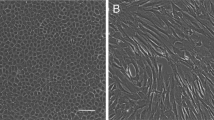Abstract
Objective
To establish a dermal sheath cell line, a dermal papilla cell line and a outer root sheath cell line from Cashmere goat and clarify the similarities and differences among them.
Results
We established a dermal sheath cell line, a dermal papilla cell line and a outer root sheath cell line from the pelage skin hair follicles of Cashmere goat. The growth rate of dermal sheath cells was intermediate between that of dermal papilla cells and outer root sheath cells. Immunofluorescence experiments and reverse transcription-polymerase chain reaction analysis showed that at both the transcriptional and translational levels, the dermal sheath cells were alpha-smooth muscle actin (α-SMA)+/cytokeratin 13+, while the dermal papilla cells were α-SMA+/cytokeratin 13- and the outer root sheath cells were α-SMA-/cytokeratin 13+. Patterns of cytokeratin 13 expression could distinguish the dermal sheath cells from the dermal papilla cells.
Conclusions
These results suggest that cytokeratin 13 could serve as a novel biomarker for dermal sheath cells of Cashmere goat, and should prove useful for researchers investigating dermal stem cells or interaction of different types of cells during hair cycle.





Similar content being viewed by others
References
Anne-Catherine F, Yann B, Denis M (2008) Control of thrombin signaling through PI3 K is a mechanism underlying plasticity between hair follicle dermal sheath and papilla cells. J Cell Sci 121:1435–1443
Biernaskie J, Paris M, Morozova O, Fagan BM, Marra M, Pevny L, Miller FD (2009) SKPs derive from hair follicle precursors and exhibit properties of adult dermal stem cells. Cell Stem Cell 5:610–623
Bloor BK, Seddon SV, Morgan PR (2000) Gene expression of differentiation-specific keratins (K4, K13, K1 and K10) in oral non-dysplastic keratoses and lichen planus. J Oral Pathol Med 29:376–384
Cui Z et al (2012) Establishment and characterization of outer root sheath (ORS) cell line from Jining grey goat. Biotechnol Lett 34:433–440. https://doi.org/10.1007/s10529-011-0799-x
Feutz AC, Barrandon Y, Monard D (2008) Control of thrombin signaling through PI3 K is a mechanism underlying plasticity between hair follicle dermal sheath and papilla cells. J Cell Sci 121:1435–1443
Horne KA, Jahoda CA, Oliver RF (1986) Whisker growth induced by implantation of cultured vibrissa dermal papilla cells in the adult rat. J Embryol Exp Morphol 97:111
Jahoda CAB, Oliver RF (1984) Vibrissa dermal papilla cell aggregative behaviour in vivo and in vitro. J Embryol Exp Morphol 79:211–224
Jahoda C, Reynolds AJ, Chaponnier C, Forester JC, Gabbiani G (1991) Smooth muscle alpha-actin is a marker for hair follicle dermis in vivo and in vitro. J Cell Sci 99:627–636
Kishimoto J, Burgeson RE, Morgan BA (2000) Wnt signaling maintains the hair-inducing activity of the dermal papilla. Genes Dev 14:1181–1185
Ma DPJH et al (2008) A highly enriched niche of precursor cells with neuronal and glial potential within the hair follicle dermal papilla of adult skin. Stem Cells 26:163
Mc Elwee KJ, Kissling S, Wenzel E, Huth A, Hoffmann R (2003) Cultured peribulbar dermal sheath cells can induce hair follicle development and contribute to the dermal sheath and dermal papilla. J Investig Dermatol 121:1267–1275
Rahmani W et al (2014) Hair follicle dermal stem cells regenerate the dermal sheath, repopulate the dermal papilla, and modulate hair type. Dev Cell 31:543–558
Stark HJ, Breitkreutz D, Limat A, Ryle CM, Roop D, Leigh I, Fusenig N (1990) Keratins 1 and 10 or homologues as regular constituents of inner root sheath and cuticle cells in the human hair follicle. Eur J Cell Biol 52:359–372
Tobin DJ, Gunin A, Magerl M, Handijski B, Paus R (2003) Plasticity and cytokinetic dynamics of the hair follicle mesenchyme: implications for hair growth control. J Investig Dermatol 120:895–904
Wang X, Tredget EE, Wu Y (2011) Dynamic signals for hair follicle development and regeneration. Stem Cells Dev 21:7–18
Wang AB, Jain P, Tumbar T (2015) The hair follicle stem cell niche: the bulge and its environment. Tissue-Specific Stem Cell Niche. Springer, New York, pp 1–26
Yamao M, Inamatsu M, Ogawa Y, Toki H, Okada T, Toyoshima KE, Yoshizato K (2010) Contact between dermal papilla cells and dermal sheath cells enhances the ability of DPCs to induce hair growth. J Investig Dermatol 130:2707–2718
Yang C-C, Cotsarelis G (2010) Review of hair follicle dermal cells. J Dermatol Sci 57:2–11
Zhou L, Yang K, Wickett RR, Andl T, Zhang Y (2016) Dermal sheath cells contribute to postnatal hair follicle growth and cycling. J Dermatol Sci 82:129–131
Zhu B, Xu T, Yuan J, Guo X, Liu D (2013) Transcriptome sequencing reveals differences between primary and secondary hair follicle-derived dermal papilla cells of the Cashmere goat (Capra hircus). PLoS ONE 8:e76282
Zhu B et al (2014) Transcriptome sequencing reveals differences between anagen and telogen secondary hair follicle-derived dermal papilla cells of the Cashmere goat (Capra hircus). Physiol Genomics 46:104–111
Acknowledgements
This work was supported by the Inner Mongolia Natural Science Foundation of China (Grant No. 2016BS0802, 2015BS0805), the Projects of Medical Scientific Research of Health & Family Planning Commission of Inner Mongolia (Grant No. 201703183), the Projects of Medical Scientific Research of Health & Family Planning Commission of Baotou (Grant No. WSJJ2016060), the Health Research Projects of Metallurgical Safety and Health Branch of Chinese Society for Metals (Grant No. JKWS201639), and the Science & Technology Project of Quality Control of China (Grant No. 2015IK176).
Author information
Authors and Affiliations
Corresponding author
Ethics declarations
Conflict of interest
We declare that we have no conflicts of interest.
Rights and permissions
About this article
Cite this article
Zhu, B., Guo, Z., Jin, M. et al. Establishment of dermal sheath cell line from Cashmere goat and characterizing cytokeratin 13 as its novel biomarker. Biotechnol Lett 40, 765–772 (2018). https://doi.org/10.1007/s10529-018-2532-5
Received:
Accepted:
Published:
Issue Date:
DOI: https://doi.org/10.1007/s10529-018-2532-5




